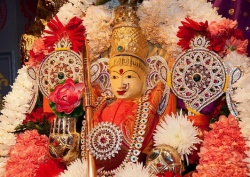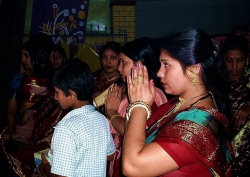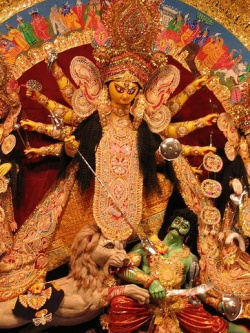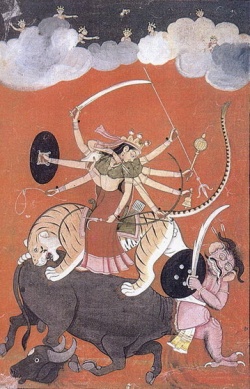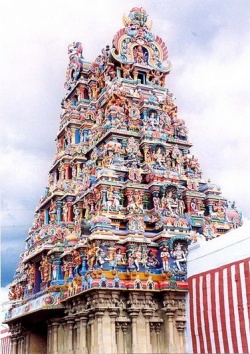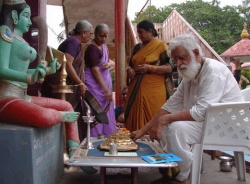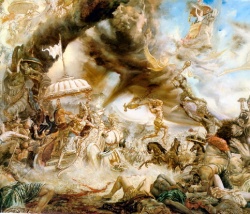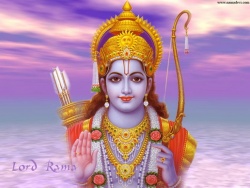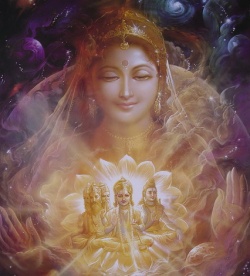Difference between revisions of "Shaktism"
m (Text replacement - "]]]" to "]])") |
|||
| (2 intermediate revisions by 2 users not shown) | |||
| Line 26: | Line 26: | ||
The [[religious]] [[scholar]] C. MacKenzie Brown explains that [[Shaktism]] "clearly insists that, of the two {{Wiki|genders}}, the {{Wiki|feminine}} represents the dominant [[power]] in the [[universe]]. Yet both {{Wiki|genders}} must be included in the [[ultimate]] if it is truly [[ultimate]]. The {{Wiki|masculine}} and the {{Wiki|feminine}} are aspects of the [[divine]], [[transcendent]] [[reality]], which goes [[beyond]] but still encompasses them. [[Devi]], in her [[supreme]] [[form]] as [[consciousness]] thus transcends [[gender]], but her {{Wiki|transcendence}} is not apart from her immanence." | The [[religious]] [[scholar]] C. MacKenzie Brown explains that [[Shaktism]] "clearly insists that, of the two {{Wiki|genders}}, the {{Wiki|feminine}} represents the dominant [[power]] in the [[universe]]. Yet both {{Wiki|genders}} must be included in the [[ultimate]] if it is truly [[ultimate]]. The {{Wiki|masculine}} and the {{Wiki|feminine}} are aspects of the [[divine]], [[transcendent]] [[reality]], which goes [[beyond]] but still encompasses them. [[Devi]], in her [[supreme]] [[form]] as [[consciousness]] thus transcends [[gender]], but her {{Wiki|transcendence}} is not apart from her immanence." | ||
| − | Brown's [[analysis]] continues, "Indeed, this [[affirmation]] of the [[oneness]] of {{Wiki|transcendence}} and immanence constitutes the very [[essence]] of the [[divine mother]] [and her] [[ultimate]] {{Wiki|triumph}}. It is not, finally, that she is infinitely {{Wiki|superior}} to the {{Wiki|male}} [[gods]] – though she is that, according to | + | Brown's [[analysis]] continues, "Indeed, this [[affirmation]] of the [[oneness]] of {{Wiki|transcendence}} and immanence constitutes the very [[essence]] of the [[divine mother]] [and her] [[ultimate]] {{Wiki|triumph}}. It is not, finally, that she is infinitely {{Wiki|superior}} to the {{Wiki|male}} [[gods]] – though she is that, according to ([[Shaktism]]) – but rather that she transcends her own {{Wiki|feminine}} {{Wiki|nature}} as Prakriti without denying it." |
Association with [[Tantra]] | Association with [[Tantra]] | ||
| Line 46: | Line 46: | ||
Shaktas may approach the [[Devi]] in any of a vast number of [[forms]]; however, they are all considered to be but diverse aspects of the one [[supreme]] [[goddess]]. | Shaktas may approach the [[Devi]] in any of a vast number of [[forms]]; however, they are all considered to be but diverse aspects of the one [[supreme]] [[goddess]]. | ||
[[File:Durga_Mahisasuramardini.JPG|thumb|250px|]] | [[File:Durga_Mahisasuramardini.JPG|thumb|250px|]] | ||
| − | With the many names used to refer to her – Devī, Caṇḍikā, Ambikā, [[Kālī]], and a profusion of others – it is easy to forget that the [[Devi]] is indeed one. [In the {{Wiki|central}} {{Wiki|Shakta}} [[scripture]] [[Devi]] Mahatmyam], the [[Devi]] reveals that she is one without a second, saying, "I am alone here in the [[world]]. Who else is there besides me?" Following this proclamation of [[divine]] unity, which has been called the mahāvākya, or great dictum of Devīmāhātmya, she explains that all [other [[goddesses]] | + | With the many names used to refer to her – Devī, Caṇḍikā, Ambikā, [[Kālī]], and a profusion of others – it is easy to forget that the [[Devi]] is indeed one. [In the {{Wiki|central}} {{Wiki|Shakta}} [[scripture]] [[Devi]] Mahatmyam], the [[Devi]] reveals that she is one without a second, saying, "I am alone here in the [[world]]. Who else is there besides me?" Following this proclamation of [[divine]] unity, which has been called the mahāvākya, or great dictum of Devīmāhātmya, she explains that all [other [[goddesses]]) are but projections of her [[power]], as are all the other [[forms]] she inhabits. |
The [[primary]] [[Devi]] [[form]] worshiped by a {{Wiki|Shakta}} is his or her ishta-devi. The [[selection]] of this [[deity]] can depend on many factors, including family [[tradition]], regional practice, [[guru]] [[lineage]], personal resonance and so on. There are literally thousands of [[goddess]] [[forms]], many of them associated with particular [[temples]], geographic {{Wiki|features}} or even {{Wiki|individual}} villages. Nonetheless, several highly popular [[goddess]] [[forms]] are known and worshiped throughout the [[Hindu]] [[world]], and virtually every {{Wiki|female}} [[deity]] in [[Hinduism]] is believed to be a [[manifestation]] of one or more of these "basic" [[forms]]. The best-known {{Wiki|benevolent}} [[goddesses]] of popular [[Hinduism]] include: | The [[primary]] [[Devi]] [[form]] worshiped by a {{Wiki|Shakta}} is his or her ishta-devi. The [[selection]] of this [[deity]] can depend on many factors, including family [[tradition]], regional practice, [[guru]] [[lineage]], personal resonance and so on. There are literally thousands of [[goddess]] [[forms]], many of them associated with particular [[temples]], geographic {{Wiki|features}} or even {{Wiki|individual}} villages. Nonetheless, several highly popular [[goddess]] [[forms]] are known and worshiped throughout the [[Hindu]] [[world]], and virtually every {{Wiki|female}} [[deity]] in [[Hinduism]] is believed to be a [[manifestation]] of one or more of these "basic" [[forms]]. The best-known {{Wiki|benevolent}} [[goddesses]] of popular [[Hinduism]] include: | ||
| Line 123: | Line 123: | ||
She is "the [[loving]] mother who protects her children and whose fierceness guards them. She is outwardly frightening – with dark {{Wiki|skin}}, pointed teeth, and a necklace of skulls – but inwardly [[beautiful]]. She can guarantee a good [[rebirth]] or great [[religious]] [[insight]], and her {{Wiki|worship}} is often communal – especially at festivals, such as [[Kali]] [[Puja]] and {{Wiki|Durga}} [[Puja]]. {{Wiki|Worship}} may involve {{Wiki|contemplation}} of the devotee's union with or [[love]] of the [[goddess]], [[visualization]] of her [[form]], [[chanting]] [of her] [[mantras]], [[prayer]] before her {{Wiki|image}} or yantra, and giving [of] [[offerings]]." | She is "the [[loving]] mother who protects her children and whose fierceness guards them. She is outwardly frightening – with dark {{Wiki|skin}}, pointed teeth, and a necklace of skulls – but inwardly [[beautiful]]. She can guarantee a good [[rebirth]] or great [[religious]] [[insight]], and her {{Wiki|worship}} is often communal – especially at festivals, such as [[Kali]] [[Puja]] and {{Wiki|Durga}} [[Puja]]. {{Wiki|Worship}} may involve {{Wiki|contemplation}} of the devotee's union with or [[love]] of the [[goddess]], [[visualization]] of her [[form]], [[chanting]] [of her] [[mantras]], [[prayer]] before her {{Wiki|image}} or yantra, and giving [of] [[offerings]]." | ||
| − | At Tarapith, Devi's [[manifestation]] as [[Tara]] ("She Who Saves") or Ugratara ("Fierce [[Tara]]") is ascendant, as the [[goddess]] who gives [[liberation]] (kaivalyadayini). [...] The [[forms]] of [[sadhana]] performed here are more [[yogic]] and [[tantric]] than devotional, and they often involve sitting alone at the | + | At Tarapith, Devi's [[manifestation]] as [[Tara]] ("She Who Saves") or Ugratara ("Fierce [[Tara]]") is ascendant, as the [[goddess]] who gives [[liberation]] (kaivalyadayini). [...] The [[forms]] of [[sadhana]] performed here are more [[yogic]] and [[tantric]] than devotional, and they often involve sitting alone at the ([[cremation]]) ground, surrounded by ash and bone. There are {{Wiki|shamanic}} [[elements]] associated with the Tarapith [[tradition]], including 'conquest of the [[goddess]]', {{Wiki|exorcism}}, [[trance]], and control of [[spirits]]." |
The [[philosophical]] and devotional underpinning of all such [[ritual]], however, {{Wiki|remains}} a pervasive [[vision]] of the [[Devi]] as [[supreme]], [[absolute]] [[divinity]]. As expressed by the nineteenth-century [[saint]] {{Wiki|Ramakrishna}}, one of the most influential figures in {{Wiki|modern}} {{Wiki|Bengali}} [[Shaktism]]: | The [[philosophical]] and devotional underpinning of all such [[ritual]], however, {{Wiki|remains}} a pervasive [[vision]] of the [[Devi]] as [[supreme]], [[absolute]] [[divinity]]. As expressed by the nineteenth-century [[saint]] {{Wiki|Ramakrishna}}, one of the most influential figures in {{Wiki|modern}} {{Wiki|Bengali}} [[Shaktism]]: | ||
| Line 136: | Line 136: | ||
The most important {{Wiki|Shakta}} {{Wiki|festival}} is Navratri (lit., "{{Wiki|Festival}} of Nine Nights"), also known as "Sharad Navratri" because it falls during the [[Hindu]] month of Sharad (October/November). This {{Wiki|festival}} – often taken together with the following tenth day, known as Dusshera or Vijayadashami – celebrates the [[goddess]] Durga's victory over a series of {{Wiki|powerful}} [[demons]] in the [[Devi]] Mahatmya. In {{Wiki|Bengal}}, the last four days of Navaratri are called {{Wiki|Durga}} [[Puja]], and mark one episode in particular: Durga's {{Wiki|iconic}} slaying of {{Wiki|Mahishasura}} (lit., the "Buffalo [[Demon]]"). | The most important {{Wiki|Shakta}} {{Wiki|festival}} is Navratri (lit., "{{Wiki|Festival}} of Nine Nights"), also known as "Sharad Navratri" because it falls during the [[Hindu]] month of Sharad (October/November). This {{Wiki|festival}} – often taken together with the following tenth day, known as Dusshera or Vijayadashami – celebrates the [[goddess]] Durga's victory over a series of {{Wiki|powerful}} [[demons]] in the [[Devi]] Mahatmya. In {{Wiki|Bengal}}, the last four days of Navaratri are called {{Wiki|Durga}} [[Puja]], and mark one episode in particular: Durga's {{Wiki|iconic}} slaying of {{Wiki|Mahishasura}} (lit., the "Buffalo [[Demon]]"). | ||
[[File:Shwaracharya.jpg|thumb|250px|]] | [[File:Shwaracharya.jpg|thumb|250px|]] | ||
| − | While [[Hindus]] of all denominations celebrate the autumn Navratri {{Wiki|festival}}, Shaktas also celebrate two additional Navratris – one in the spring and one in the summer. The spring {{Wiki|festival}} is known as [[Vasanta]] Navaratri or [[Chaitra]] Navatri, and celebrated in the [[Hindu]] month of [[Chaitra]] (March/April). Srividya [[lineages]] dedicate this {{Wiki|festival}} to Devi's [[form]] as the [[goddess]] Lalita. The summer {{Wiki|festival}} is called Ashada Navaratri, as it is held during the [[Hindu]] month of Ashadha (June/July). The hugely popular Vaishno [[Devi]] [[temple]] in Jammu | + | While [[Hindus]] of all denominations celebrate the autumn Navratri {{Wiki|festival}}, Shaktas also celebrate two additional Navratris – one in the spring and one in the summer. The spring {{Wiki|festival}} is known as [[Vasanta]] Navaratri or [[Chaitra]] Navatri, and celebrated in the [[Hindu]] month of [[Chaitra]] (March/April). Srividya [[lineages]] dedicate this {{Wiki|festival}} to Devi's [[form]] as the [[goddess]] Lalita. The summer {{Wiki|festival}} is called Ashada Navaratri, as it is held during the [[Hindu]] month of Ashadha (June/July). The hugely popular Vaishno [[Devi]] [[temple]] in Jammu observes its major Navaratri celebration during this period. Ashada Navaratri, on the other hand, is considered particularly [[auspicious]] for {{Wiki|devotees}} of the boar-headed [[goddess]] Varahi, one of the seven {{Wiki|Matrikas}} named in the [[Devi]] Mahatmya. |
Vasant Panchami | Vasant Panchami | ||
| Line 151: | Line 151: | ||
There are variant dates for [[Saraswati]] [[Puja]], depending upon region and local [[tradition]]. Commonly, on the fifth day of the [[Hindu]] month of Phalguna (January–February), students offer their [[books]] and musical instruments to [[Saraswati]] and pray for her [[blessings]] in their studies. In some parts of [[India]], [[Saraswati]] [[Puja]] is celebrated in the month of Magh; in others, during the final three days of Navratri. | There are variant dates for [[Saraswati]] [[Puja]], depending upon region and local [[tradition]]. Commonly, on the fifth day of the [[Hindu]] month of Phalguna (January–February), students offer their [[books]] and musical instruments to [[Saraswati]] and pray for her [[blessings]] in their studies. In some parts of [[India]], [[Saraswati]] [[Puja]] is celebrated in the month of Magh; in others, during the final three days of Navratri. | ||
| − | Major {{Wiki|Shakta}} [[temple]] festivals are Meenakshi Kalyanam and Ambubachi Mela. Meenakshi Kalyanam | + | Major {{Wiki|Shakta}} [[temple]] festivals are Meenakshi Kalyanam and Ambubachi Mela. Meenakshi Kalyanam observes the [[auspicious]] occasion of Devi's [[marriage]] (as Meenakshi) to [[Lord]] Sundareshwara ([[Shiva]]) is centered around the Meenakshi Amman [[Temple]] in Madurai, Tamil Nadu. It runs for 12 days, counting from the second day of the [[lunar month]] of [[Chaitra]], in April or May. Ambubachi Mela is a celebration of the yearly menstruation of the [[goddess]], held in June/July (during the monsoon season) at Kamakhya [[Temple]], Guwahati, {{Wiki|Assam}}. Here the [[Devi]] is worshiped in the [[form]] of a yoni-like stone over which a naturally red-tinted spring flows. |
[[Temples]] | [[Temples]] | ||
There are thousands of [[Shakti]] [[temples]]; vast or tiny, famous or obscure. Moreover, countless cities, towns, villages and geographic landmarks are named for various [[forms]] of the [[Devi]]. "In this vast country, {{Wiki|holy}} resorts of the [[goddess]] are innumerable and the popularity of her {{Wiki|cult}} is proved even in the place-names of [[India]]." | There are thousands of [[Shakti]] [[temples]]; vast or tiny, famous or obscure. Moreover, countless cities, towns, villages and geographic landmarks are named for various [[forms]] of the [[Devi]]. "In this vast country, {{Wiki|holy}} resorts of the [[goddess]] are innumerable and the popularity of her {{Wiki|cult}} is proved even in the place-names of [[India]]." | ||
| − | At various times, different writers have attempted to organize some of these into lists of "[[Shakti]] Peethas"; literally "Seats of the [[Devi]]", or more broadly, "Places of [[Power]]". Numbering anywhere from four to 51 (in the most famous list, found in the [[Tantra]] Cudamani), "the peethas [became] a popular theme of the {{Wiki|medieval}} writers, many of whom took the greatest liberty in [[fabricating]] the place names, the [[goddesses]] and their bhairavas | + | At various times, different writers have attempted to organize some of these into lists of "[[Shakti]] Peethas"; literally "Seats of the [[Devi]]", or more broadly, "Places of [[Power]]". Numbering anywhere from four to 51 (in the most famous list, found in the [[Tantra]] Cudamani), "the peethas [became] a popular theme of the {{Wiki|medieval}} writers, many of whom took the greatest liberty in [[fabricating]] the place names, the [[goddesses]] and their bhairavas ([[consorts]])." |
[[Criticism]] | [[Criticism]] | ||
Latest revision as of 03:07, 5 April 2016
Shaktism focuses worship upon the Hindu Divine Mother, here represented as (foreground) Lajja Gauri or Aditi, the original Mother of the Cosmos, and (background) as the mystical yantra known as Sri Meru. Shaktism (Sanskrit: Śāktaṃ, शाक्तं; lit., 'doctrine of power' or 'doctrine of the Goddess') is a denomination of Hinduism that focuses worship upon Shakti or Devi – the Hindu Divine Mother – as the absolute, ultimate Godhead. It is, along with Shaivism and Vaisnavism, one of the primary schools of devotional Hinduism.
Shaktism regards Devi (lit., 'the Goddess') as the Supreme Brahman itself, the "one without a second", with all other forms of divinity, female or male, considered to be merely her diverse manifestations. In the details of its philosophy and practice, Shaktism resembles Shaivism. However, Shaktas (Sanskrit: Śākta, शाक्त), practitioners of Shaktism, focus most or all worship on Shakti, as the dynamic feminine aspect of the Supreme Divine. Shiva, the masculine aspect of divinity, is considered solely transcendent, and his worship is usually relegated to an auxiliary role.
The roots of Shaktism penetrate deep into India's prehistory. From the Goddess's earliest known appearance in Indian paleolithic settlements more than 22,000 years ago, through the refinement of her cult in the Indus Valley Civilization, her partial eclipse during the Vedic period, and her subsequent resurfacing and expansion in the classical Sanskrit tradition, it has been suggested that, in many ways, "the history of the Hindu tradition can be seen as a reemergence of the feminine."
Over the course of its history, Shaktism has inspired great works of Sanskrit literature and Hindu philosophy, and it continues to strongly influence popular Hinduism today. Shaktism is practiced throughout the Indian subcontinent and beyond, in numerous forms, both Tantric and non-Tantric; however, its two largest and most visible schools are the Srikula (lit., family of Sri), strongest in South India, and the Kalikula (family of Kali), which prevails in northern and eastern India.
Shakti and Shiva
Shaktas conceive the Goddess as the supreme, ultimate Godhead. She is considered to be simultaneously the source of all creation, as well as its embodiment and the energy that animates and governs it. It has been observed that "nowhere in the religious history of the world do we come across such a completely female-oriented system."
Shaktism's focus on the Divine Feminine does not imply a rejection of Masculine or Neuter divinity. However, both are deemed to be inactive in the absence of Shakti. As set out in the first line of Adi Shankara's renowned Shakta hymn, Saundaryalahari (c. 800 CE): "If Shiva is united with Shakti, he is able to create. If he is not, he is incapable even of stirring." This is the fundamental tenet of Shaktism , as emphasized in the widely known image of the goddess Kali striding atop the seemingly lifeless body of Shiva.
Shiva and Shakti in the half-male, half-female form of Ardhanari. (Elephanta caves, 5th century CE. Mumbai, India.)
Broadly speaking, Shakti is considered to be the cosmos itself – she is the embodiment of energy and dynamism, and the motivating force behind all action and existence in the material universe. Shiva is her transcendent masculine aspect, providing the divine ground of all being. "There is no Shiva without Shakti, or Shakti without Shiva. The two [...] in themselves are One."
As expressed by the historian V. R. Ramachandra Dikshitar (here referring to Shiva as Brahman), "Shaktism is dynamic Hinduism. The excellence of Shaktism lies in its affirmation of Shakti as Consciousness and of the identity of Shakti and Brahman. In short, Brahman is static Shakti and Shakti is dynamic Brahman." In religious art, this cosmic dynamic is powerfully expressed in the half-Shakti, half-Shiva deity known as Ardhanari.
Shaktism views the Devi as the source, essence and substance of virtually everything in creation, seen or unseen, including Shiva himself. In the Devi-Bhagavata Purana, a central Shakta scripture, the Devi declares:
"I am Manifest Divinity, Unmanifest Divinity, and Transcendent Divinity. I am Brahma, Vishnu and Shiva, as well as Saraswati, Lakshmi and Parvati. I am the Sun and I am the Stars, and I am also the Moon. I am all animals and birds, and I am the outcaste as well, and the thief. I am the low person of dreadful deeds, and the great person of excellent deeds. I am Female, I am Male, and I am Neuter."
The religious scholar C. MacKenzie Brown explains that Shaktism "clearly insists that, of the two genders, the feminine represents the dominant power in the universe. Yet both genders must be included in the ultimate if it is truly ultimate. The masculine and the feminine are aspects of the divine, transcendent reality, which goes beyond but still encompasses them. Devi, in her supreme form as consciousness thus transcends gender, but her transcendence is not apart from her immanence."
Brown's analysis continues, "Indeed, this affirmation of the oneness of transcendence and immanence constitutes the very essence of the divine mother [and her] ultimate triumph. It is not, finally, that she is infinitely superior to the male gods – though she is that, according to (Shaktism) – but rather that she transcends her own feminine nature as Prakriti without denying it."
Association with Tantra
A widely misunderstood aspect of Shaktism is its close association with Tantrism – an ambiguous, often provocative concept that suggests everything from orthodox temple worship in the south of India, to black magic and occult practices in North India, to ritualized sexual practices (sometimes referred to as "Neotantra") in the West. In fact, not all forms of Shaktism are Tantric in nature, just as not all forms of Tantra are Shaktic in nature.
When the term "Tantra" is used in relation to authentic Hindu Shaktism, it most often refers to a class of ritual manuals, and – more broadly – to an esoteric methodology of Goddess-focused spiritual practice (sadhana) involving mantra, yantra, nyasa, mudra and certain elements of traditional kundalini yoga, all practiced under the guidance of a qualified guru after due initiation (diksha) and oral instruction to supplement various written sources.
In its social interactions, Shakta Tantra is "free from all sorts of caste and patriarchal prejudices. A woman or a shudra is entitled to function in the role of guru. All women are regarded as manifestations of Shakti, and hence they are the object of respect and devotion. Whoever offends them incurs the wrath of the great goddess. Every [[[Wikipedia:male|male]] aspirant] has to realize the latent Female Principle within himself, and only by [thus] 'becoming female' is he entitled to worship the Supreme Being"
More controversial ritual practices, such as the "Five Ms" or panchamakara, are employed under certain circumstances by some Tantric Shakta sects. However, these elements tend to be overemphasized and sensationalized by commentators (both friendly and hostile) who are ill-informed regarding authentic doctrine and practice. Moreover, even within the tradition there are wide differences of opinion regarding the proper interpretation of the panchamakara, and some lineages reject them altogether.
In sum, the complex social and historical interrelations of Tantric and non-Tantric elements in Shaktism – and Hinduism in general – are an extremely fraught and nuanced topic of discussion. However, as a general rule:
"Ideas and practices that collectively characterize Tantrism pervade classical Hinduism [and] it would be an error to consider Tantrism apart from its complex interrelations with non-Tantric traditions. Literary history demonstrates that Vedic-oriented brahmins have been involved in Shakta Tantrism from its incipient stages of development, that is, from at least the sixth century. While Shakta Tantrism may have originated in [pre-Vedic, indigenous] goddess cults, any attempt to distance Shakta Tantrism from the Sanskritic Hindu traditions [...] will lead us astray."
Principal deities
Shaktas may approach the Devi in any of a vast number of forms; however, they are all considered to be but diverse aspects of the one supreme goddess.
With the many names used to refer to her – Devī, Caṇḍikā, Ambikā, Kālī, and a profusion of others – it is easy to forget that the Devi is indeed one. [In the central Shakta scripture Devi Mahatmyam], the Devi reveals that she is one without a second, saying, "I am alone here in the world. Who else is there besides me?" Following this proclamation of divine unity, which has been called the mahāvākya, or great dictum of Devīmāhātmya, she explains that all [other goddesses) are but projections of her power, as are all the other forms she inhabits.
The primary Devi form worshiped by a Shakta is his or her ishta-devi. The selection of this deity can depend on many factors, including family tradition, regional practice, guru lineage, personal resonance and so on. There are literally thousands of goddess forms, many of them associated with particular temples, geographic features or even individual villages. Nonetheless, several highly popular goddess forms are known and worshiped throughout the Hindu world, and virtually every female deity in Hinduism is believed to be a manifestation of one or more of these "basic" forms. The best-known benevolent goddesses of popular Hinduism include:
Adi Parashakti: The Goddess as Original, Transcendent Source of the Universe.
Durga (Amba, Ambika): The Goddess as Mahadevi,Material Manifestation of Supreme Divinity (Brahman)
Lakshmi (Sri): The Goddess of Material Fulfillment (wealth, health, fortune, love, beauty, fertility, etc.); consort (shakti) of Vishnu
Parvati (Gauri, Uma): The Goddess of Spiritual Fulfillment (divine love; the saguna [i.e. having material qualities] form of Adi-Parashakti); consort (shakti) of Shiva
Saraswati: The Goddess of Cultural Fulfillment (knowledge/education, music, arts and sciences, etc.); consort (shakti) of Brahma; identified with the Sarasvati River
Gayatri: The Goddess as Mother of Mantras
Ganga: The Goddess as Divine River; identified with the Ganges River
Sita: The Goddess as Rama's consort
Radha: The Goddess as Krishna's lover
Sati: The Goddess of Marital Relations; original consort (shakti) of Shiva
Tantric deities
Goddess groups – such as the "Nine Durgas" (Navadurga), "Eight Lakshmis" (Ashta-Lakshmi) or the "Fifteen Nityas" – are very common in Hinduism. But perhaps no group reveals the elements of Shaktism better than the Ten Mahavidyas (Dasamahavidya). Through them, Shaktas believe, "the one Truth is sensed in ten different facets; the Divine Mother is adored and approached as ten cosmic personalities." The Mahavidyas are considered Tantric in nature, and are usually identified as:
Kali: The Goddess as Cosmic Destruction, Death or "Devourer of Time" (Supreme Deity of Kalikula systems)
Tara: The Goddess as Guide and Protector, or the Goddess as Savior
Lalita-Tripurasundari (Shodashi): The Goddess Who is "Beautiful in the Three Worlds" (Supreme Deity of Srikula systems); the "Tantric Parvati"
Bhuvaneshvari: The Goddess as World Mother, or the Goddess Whose Body is the Earth/Cosmos
Bhairavi: The Fierce Goddess
Chhinnamasta: The Self-Decapitated Goddess
Dhumavati: The Widow Goddess
Bagalamukhi: The Goddess Who Paralyzes Enemies
Matangi: The Outcaste Goddess (in Kalikula systems); the Prime Minister of Lalita (in Srikula systems); the "Tantric Saraswati"
Kamala: The Lotus Goddess; the "Tantric Lakshmi"
Other major goddess groups include the Sapta-Matrika ("Seven Little Mothers"), "who are the energies of different major gods, and described as assisting the great Shakta Devi in her fight with demons", and the 64 Yoginis.
Historical and philosophical development
The beginnings of Shaktism are shrouded in the mists of prehistory. The earliest Mother Goddess figurine unearthed in India, belonging to the Upper Paleolithic, has been carbon-dated to approximately 20,000 BCE. Thousands of female statuettes dated as early as c. 5500 BCE have been recovered at Mehrgarh, one of the most important Neolithic sites in world archaeology. While it is impossible to reconstruct the spiritual beliefs of a civilization so distantly removed in time, current archaeological and anthropological evidence suggests that the religion of the great Indus Valley Civilization is probably a direct predecessor of modern Shaktism.
Devi portrayed as Mahishasura Mardini, Slayer of the Buffalo Demon – a central episode of the Devi Mahatmya, and one of the most famous in all of Hindu mythology.
As the Indus Valley Civilization slowly declined and dispersed, its peoples mixed with other groups to eventually give rise to Vedic Civilization (c. 1500 - 600 BCE). Shaktism as it exists today began with the literature of the Vedic Age; further evolved during the formative period of the Hindu epics; reached its full flower during the Gupta Age (300-700 CE), and continued to expand and develop thereafter.
The most central and pivotal text in Shaktism is the Devi Mahatmya (also known as the Durga Saptashati, Chandi or Chandi-Path), composed some 1,600 years ago. Here, for the first time, "the various mythic, cultic and theological elements relating to diverse female divinities were brought together in what has been called the 'crystallization of the Goddess tradition.'"
Other important texts include the canonical Shakta Upanishads, as well as Shakta-oriented Puranic literature such as the Devi Purana and Kalika Purana, the Lalita Sahasranama (from the Brahmanda Purana), the Devi Gita (from the Devi-Bhagavata Purana), Adi Shankara's Saundaryalahari and the Tantras.
Elements of Shaktism – most notably, the ubiquity of goddess worship in some form – has infused popular Hinduism. Its pervasive influence on the religion is also reflected in the Hindu adage, "When in public, be a Vaishnava. When among friends, be a Shaiva. But in private, always be a Shakta."
Recent developments related to Shaktism include the emergence of Bharat Mata ("Mother India") symbolism, the increasing visibility of Hindu female saints and gurus, and the prodigious rise of the "new" goddess Santoshi Mata following release of the Indian film Jai Santoshi Maa ("Hail to the Mother of Satisfaction") in 1975. Linda Johnsen in 'The Complete Idiot's Guide to Hinduism' notes:
"Today just as 10,000 years ago, images of the Goddess are everywhere in India. You'll find them painted on the sides of trucks, pasted to the dashboards of taxis, postered on the walls of shops. You'll often see a color painting of the Goddess prominently displayed in Hindu homes. Usually the picture is hung high on the wall so you have to crane your neck backward, looking up toward her feet. [...] In India, Goddess worship is not a 'cult,' it's a religion, [...] an extraordinarily spiritually and psychologically mature tradition. Millions of people turn every day with heartfelt yearning to the Mother of the Universe."
Worship
Shaktism encompasses a nearly endless variety of beliefs and practices – from primitive animism to philosophical speculation of the highest order – that seek to access the Shakti (Divine Energy or Power) that is believed to be the Devi's nature and form. Its two largest and most visible schools are the Srikula (family of Sri), strongest in South India, and the Kalikula (family of Kali), which prevails in northern and eastern India.
Srikula: family of Sri
The Srikula (family of Sri) tradition (sampradaya) focuses worship on Devi in the form of the goddess Lalita-Tripurasundari, who is regarded as the Great Goddess (Mahadevi). Rooted in first-millennium Kashmir, Srikula became a force in South India no later than the seventh century, and is today the prevalent form of Shaktism practiced in South Indian regions such as Andhra Pradesh, Karnataka, Kerala, Tamil Nadu and Tamil areas of Sri Lanka.
The Srikula's best-known school is Srividya, "one of Shakta Tantrism's most influential and theologically sophisticated movements." Its central symbol, the Sri Chakra, is probably the most famous visual image in all of Hindu Tantric tradition. Its literature and practice is perhaps more systematic than that of any other Shakta sect.
Srividya largely views the Goddess as "benign [saumya] and beautiful [saundarya]" (in contrast to Kalikula's focus on "terrifying [ugra] and horrifying [ghora] goddess forms such as Kali or Durga). In Srikula practice, moreover, every aspect of the Goddess – whether malignant or gentle – is identified with Lalita.
Srikula adepts most often worship Lalita using the abstract Sri Chakra yantra, which is regarded as her subtle form. The Sri Chakra can be visually rendered either as a two-dimensional diagram (whether drawn temporarily as part of the worship ritual, or permanently engraved in metal) or in the three-dimensional, pyramidal form known as the Sri Meru. It is not uncommon to find a Sri Chakra or Sri Meru installed in South Indian temples, because – as modern practitioners assert – "there is no disputing that this is the highest form of Devi and that some of the practice can be done openly. But what you see in the temples is not the srichakra worship you see when it is done privately."
The Srividya paramparas can be further broadly subdivided into two streams, the Kaula (a vamamarga practice) and the Samaya (a dakshinamarga practice). The Kaula or Kaulachara, first appeared as a coherent ritual system in the 8th century in central India, and its most revered theorist is the 18th-century philosopher Bhaskararaya, widely considered "the best exponent of Shakta philosophy."
The Samaya or Samayacharya finds its roots in the work of the 16th-century commentator Lakshmidhara, and is "fiercely puritanical [in its] attempts to reform Tantric practice in ways that bring it in line with high-caste brahmanical norms." Many Samaya practitioners explicitly deny being either Shakta or Tantric, though scholars argues that their cult remains technically both. The Samaya-Kaula division marks "an old dispute within Hindu Tantrism," and one that is vigorously debated to this day.
Kalikula: family of Kali
The Kalikula (family of Kali) form of Shaktism is most dominant in northern and eastern India, and is most widely prevalent in West Bengal, Assam, Bihar and Odisha, as well as parts of Maharashtra and Bangladesh. Kalikula lineages focus upon the Devi as the source of wisdom (vidya) and liberation (moksha). They generally stand "in opposition to the brahmanic tradition," which they view as "overly conservative and denying the experiential part of religion."
The Devi as Durga, in her form as Mahishasura Mardini, "Slayer of the Buffalo Demon, Mahishasura. Photographed at a pandal (temporary shrine) in t Maddox Square, Kolkata, during Durga
The main deities of Kalikula are Kali, Chandi and Durga. Other goddesses that enjoy veneration are Tara and all the other Mahavidyas as well as regional goddesses such as Manasa, the snake goddess, and Sitala, the smallpox goddess – all of them, again, considered aspects of the Divine Mother.
Two major centers of Shaktism in West Bengal are Kalighat in Calcutta and Tarapith in Birbhum district. In Calcutta, emphasis is on devotion (bhakti) to the goddess as Kali:
She is "the loving mother who protects her children and whose fierceness guards them. She is outwardly frightening – with dark skin, pointed teeth, and a necklace of skulls – but inwardly beautiful. She can guarantee a good rebirth or great religious insight, and her worship is often communal – especially at festivals, such as Kali Puja and Durga Puja. Worship may involve contemplation of the devotee's union with or love of the goddess, visualization of her form, chanting [of her] mantras, prayer before her image or yantra, and giving [of] offerings."
At Tarapith, Devi's manifestation as Tara ("She Who Saves") or Ugratara ("Fierce Tara") is ascendant, as the goddess who gives liberation (kaivalyadayini). [...] The forms of sadhana performed here are more yogic and tantric than devotional, and they often involve sitting alone at the (cremation) ground, surrounded by ash and bone. There are shamanic elements associated with the Tarapith tradition, including 'conquest of the goddess', exorcism, trance, and control of spirits."
The philosophical and devotional underpinning of all such ritual, however, remains a pervasive vision of the Devi as supreme, absolute divinity. As expressed by the nineteenth-century saint Ramakrishna, one of the most influential figures in modern Bengali Shaktism:
"Kali is none other than Brahman. That which is called Brahman is really Kali. She is the Primal Energy. When that Energy remains inactive, I call It Brahman, and when It creates, preserves, or destroys, I call It Shakti or Kali. What you call Brahman I call Kali. Brahman and Kali are not different. They are like fire and its power to burn: if one thinks of fire one must think of its power to burn. If one recognizes Kali one must also recognize Brahman; again, if one recognizes Brahman one must recognize Kali. Brahman and Its Power are identical. It is Brahman whom I address as Shakti or Kali."
Festivals
Shaktas celebrate most major Hindu festivals, as well as a huge variety of local, temple- or deity-specific observances. A few of the more important events are listed below:
Navratri
The most important Shakta festival is Navratri (lit., "Festival of Nine Nights"), also known as "Sharad Navratri" because it falls during the Hindu month of Sharad (October/November). This festival – often taken together with the following tenth day, known as Dusshera or Vijayadashami – celebrates the goddess Durga's victory over a series of powerful demons in the Devi Mahatmya. In Bengal, the last four days of Navaratri are called Durga Puja, and mark one episode in particular: Durga's iconic slaying of Mahishasura (lit., the "Buffalo Demon").
While Hindus of all denominations celebrate the autumn Navratri festival, Shaktas also celebrate two additional Navratris – one in the spring and one in the summer. The spring festival is known as Vasanta Navaratri or Chaitra Navatri, and celebrated in the Hindu month of Chaitra (March/April). Srividya lineages dedicate this festival to Devi's form as the goddess Lalita. The summer festival is called Ashada Navaratri, as it is held during the Hindu month of Ashadha (June/July). The hugely popular Vaishno Devi temple in Jammu observes its major Navaratri celebration during this period. Ashada Navaratri, on the other hand, is considered particularly auspicious for devotees of the boar-headed goddess Varahi, one of the seven Matrikas named in the Devi Mahatmya.
Vasant Panchami
Fifth day of Magha Gupta Navratri is very important for all branches of Shakta-pantha. Specially in Vindhyachal mahashakti peetham, thousands of chandipatha and other secret rituals performed this day to please Aadishakti. This is the festival of union of Shakti & Shiv (Shiva-Shiv). On the same basis Shiva-Shiv Sammoh is formed by Awadhoot Kripanandnath at Awadhoot Ashram, Vindhyachal in 1980.
Diwali and others
Lakshmi Puja is observed by Shaktas and many other Hindus on the full moon night following the autumn Durga Puja. Lakshmi's biggest festival, however, is Diwali (or Deepavali; the "Festival of Lights"), a major Hindu holiday celebrated across India. In North India, Diwali marks the beginning of the traditional New Year, and is held on the night of the new moon in the Hindu month of Kartik (usually October or November). Shaktas (and many non-Shaktas) celebrate it as another Lakshmi Puja, placing small oil lamps outside their homes and praying for the goddess's blessings. Diwali coincides with the celebration of Kali Puja, popular in Bengal, and some Shakta traditions focus their worship on Devi as Kali rather than Lakshmi.
Jagaddhatri Puja is celebrated on the last four days of the Navaratis, following Kali Puja. It is very similar to Durga Puja in its details and observance, and is especially popular in Bengal and some other parts of Eastern India.
Gauri Puja is performed on the fifth day after Ganesh Chaturthi, during Ganesha Puja in Western India, to celebrate the arrival of Gauri, Mother of Ganesha, to come and bring her son back home.
There are variant dates for Saraswati Puja, depending upon region and local tradition. Commonly, on the fifth day of the Hindu month of Phalguna (January–February), students offer their books and musical instruments to Saraswati and pray for her blessings in their studies. In some parts of India, Saraswati Puja is celebrated in the month of Magh; in others, during the final three days of Navratri.
Major Shakta temple festivals are Meenakshi Kalyanam and Ambubachi Mela. Meenakshi Kalyanam observes the auspicious occasion of Devi's marriage (as Meenakshi) to Lord Sundareshwara (Shiva) is centered around the Meenakshi Amman Temple in Madurai, Tamil Nadu. It runs for 12 days, counting from the second day of the lunar month of Chaitra, in April or May. Ambubachi Mela is a celebration of the yearly menstruation of the goddess, held in June/July (during the monsoon season) at Kamakhya Temple, Guwahati, Assam. Here the Devi is worshiped in the form of a yoni-like stone over which a naturally red-tinted spring flows.
Temples
There are thousands of Shakti temples; vast or tiny, famous or obscure. Moreover, countless cities, towns, villages and geographic landmarks are named for various forms of the Devi. "In this vast country, holy resorts of the goddess are innumerable and the popularity of her cult is proved even in the place-names of India."
At various times, different writers have attempted to organize some of these into lists of "Shakti Peethas"; literally "Seats of the Devi", or more broadly, "Places of Power". Numbering anywhere from four to 51 (in the most famous list, found in the Tantra Cudamani), "the peethas [became] a popular theme of the medieval writers, many of whom took the greatest liberty in fabricating the place names, the goddesses and their bhairavas (consorts)."
Criticism
Shaktism has at times been dismissed as a superstitious, black magic-infested practice that hardly qualifies as a true religion at all. A representative criticism of this sort issued from an Indian scholar in the 1920s:
"The Tantras are the bible of Shaktism, identifying all Force with the female principle in nature and teaching an undue adoration of the wives of Shiva and Vishnu to the neglect of their male counterparts. It is certain that a vast number of the inhabitants of India are guided in their daily life by Tantrik teaching, and are in bondage to the gross superstitions inculcated in these writings. And indeed it can scarcely be doubted that Shaktism is Hinduism arrived at its worst and most corrupt stage of development."
Scholars variously attribute such criticism to ignorance, misunderstanding or sectarian bias on the part of some observers, as well as unscrupulous practices by some Shaktas. "It is in this context that many Hindus in India today deny the relevance of Tantra to their tradition, past or present, identifying what they call tantra-mantra as so much mumbo-jumbo."
Within Hinduism, it is not uncommon to encounter assertions that the Shaiva and Vaishnava schools of Hinduism lead to moksha, or spiritual liberation, whereas Shaktism leads only to siddhis (occult powers) and bhukti (material enjoyments) – or, at best, to Shaivism. For example, the late Shaiva leader Satguru Sivaya Subramuniyaswami taught that worship of the feminine manifest is merely a vehicle for reaching the masculine unmanifest, or Parasiva. Subramuniya's successor, Satguru Bodhinatha Veylanswami, recently published an essay on different Hindu approaches to God that did not discuss Shaktism at all.
Shakta theologians counter that each of the Divine Mother's forms is a Brahma Vidya, or self-contained path to supreme wisdom. The sadhaka of any one of these goddess forms "attains ultimately, if his aspiration is such, the supreme purpose of life – Self-realisation and God-realisation." Mataji Devi Vanamali of the Vanamali ashram in Rishikesh summarizes the Shakta position as follows:
"In her transcendental aspect she is Prakriti, the form of the absolute Brahman. Therefore, when we worship the Divine Mother, we are not only offering adoration to the supreme in its aspect of motherhood but also adoring the supreme absolute. She is that aspect of the supreme power by whose grace alone we shall ultimately released from the darkness of ignorance and the bondage of maya and taken to the abode of immortal knowledge, immortality, and bliss."
Expansion beyond South Asia
The practice of Shaktism is no longer confined to South Asia. Traditional Shakta temples have sprung up across Southeast Asia, the Americas, Europe, Australia and elsewhere – some enthusiastically attended by non-Indian as well as Indian diaspora Hindus. Examples in the United States include the Kali Mandir in Laguna Beach, California; and Sri Rajarajeswari Peetam, a Srividya temple in rural Rush, New York. The Rush temple was, in fact, recently the subject an in-depth academic study exploring the "dynamics of diaspora Hinduism," including the serious entry and involvement of non-Indians in traditional Hindu religious practice.
Shaktism has also become a focus of some Western spiritual seekers attempting to construct new Goddess-centered faiths. An academic study of Western Kali enthusiasts noted that, "as shown in the histories of all cross-cultural religious transplants, Kali devotionalism in the West must take on its own indigenous forms if it is to adapt to its new environment." However, these East-West fusions can also raise complex and troubling issues of cultural appropriation.
Some writers and thinkers, "notably feminists and participants in New Age spirituality who are attracted to goddess worship", have explored Kali in a new light. She is considered as a "symbol of wholeness and healing, associated especially with repressed female power and sexuality." These new interpretations mainly originate in "feminist sources, almost none of which base their interpretations on a close reading of Kali's Indian background", and tend to demonstrate the difficulty of "import[ing] the worship of a goddess from another culture [...] when the deep symbolic meanings embedded in the native culture are not available."
A powerful motivation behind Western interest is that many central concepts of Shaktism – including aspects of kundalini yoga as well as goddess worship – were once "common to the Hindu, Chaldean, Greek and Roman civilizations," but were largely superseded in the West, as well as the Near and Middle East, with the rise of the Abrahamic religions:
"Of these four great ancient civilizations, working knowledge of the inner forces of enlightenment has survived on a mass scale only in India. Only in India has the inner tradition of the Goddess endured. This is the reason the teachings of India are so precious. They offer us a glimpse of what our own ancient wisdom must have been. The Indians have preserved our lost heritage. [...] Today it is up to us to locate and restore the tradition of the living Goddess. We would do well to begin our search in India, where for not one moment in all of human history have the children of the living Goddess forgotten their Divine Mother."
